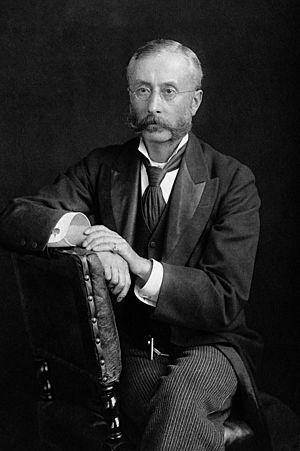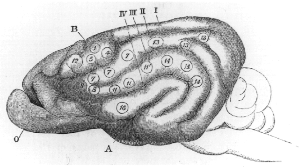David Ferrier facts for kids
Quick facts for kids
Sir David Ferrier
|
|
|---|---|
 |
|
| Born | 13 January 1843 |
| Died | 19 March 1928 (aged 85) |
| Awards | Cameron Prize for Therapeutics of the University of Edinburgh (1891) |
Sir David Ferrier (born January 13, 1843 – died March 19, 1928) was a very important Scottish doctor. He was a neurologist, which means he studied the brain and nerves. He was also a psychologist, someone who studies the mind and how people think.
Ferrier did many experiments on animal brains, like monkeys. In 1881, he was involved in a public discussion about animal research. This led to a law called the Cruelty to Animals Act, 1876.
David Ferrier's Life Story
Ferrier was born in Woodside, Aberdeen, Scotland. He went to Aberdeen Grammar School. Later, he studied at Aberdeen University, finishing in 1863. As a medical student, he worked with Alexander Bain. Bain was a famous thinker and one of the first people to study how we learn through connections.
Around 1860, the study of the mind, called psychology, started to become a real science. This happened mostly in Germany. Scientists like Hermann von Helmholtz and Wilhelm Wundt did careful research. They looked at how our senses work, like sight and hearing. In 1864, Bain encouraged Ferrier to visit their labs.
After returning to Scotland, Ferrier became a doctor in 1868. He graduated from the University of Edinburgh. In 1870, he moved to London. He started working at King's College Hospital. He also worked at the National Hospital for Paralysis and Epilepsy. This hospital, now called the National Hospital for Neurology and Neurosurgery, was the first in England to focus on brain and nerve diseases. There's even a ward named after David Ferrier today!
At this time, a great neurologist named John Hughlings Jackson worked at the same hospital. Jackson was learning more about how our nervous system controls movement and senses. He believed that different parts of the brain had specific jobs.
Jackson became a good friend and teacher to Ferrier. Because of Jackson, Ferrier decided to do his own experiments. He wanted to build on the work of two German scientists, Eduard Hitzig and Gustav Fritsch.
In 1870, Hitzig and Fritsch showed that using a small electric current on a dog's brain could make its muscles move. Ferrier also wanted to test Jackson's idea that epilepsy (a condition causing seizures) might start in the brain's outer layer, called the cortex.
Ferrier was offered a chance to lead a lab at the Stanley Royd Hospital. This was a hospital for mental health in Yorkshire. He had good equipment and many animals for his studies. In 1873, Ferrier began his experiments. He studied how removing parts of the brain or using electricity on it affected animals. When he returned to London, the Royal Society helped him continue his work with monkeys. By the end of that year, he shared his first findings.
Ferrier showed that using a small electric current on the brain of animals could create a very clear map. This map showed which parts of the brain controlled specific movements. If those same areas were damaged, the animals lost those movements. Ferrier also found that strong electrical stimulation could cause movements similar to epileptic seizures. This suggested that seizures might spread from one part of the brain.
These discoveries made Ferrier famous around the world. He became known as one of the most important experimental neurologists.
In June 1876, he became a Fellow of the Royal Society. He was only 33 years old! The next year, he became a Fellow of the Royal College of Physicians. Ferrier was also the first scientist to try to apply the brain maps he found in monkeys to human brains. Even though his ideas weren't perfectly correct, they led to important steps in brain surgery.
In 1884, a Scottish surgeon, Sir William Macewen, and two English doctors, Hughes Bennett and Sir Rickman Godlee, showed something amazing. They proved that doctors could figure out where a tumor or problem was in the brain. They did this by carefully checking how it affected a person's movement and senses. This way of mapping brain functions is still used today! Jackson and Ferrier were there for the first surgery Godlee performed on November 25, 1884.
The useful results from Ferrier's animal research helped explain his work. This was important because some groups were against animal experiments. In 1892, Ferrier helped start the National Society for the Employment of Epileptics. This group, now called the National Society for Epilepsy, helps people with epilepsy. He started it with Sir William Gowers and John Hughlings Jackson.
Later Life and Passing
Sir David Ferrier passed away from pneumonia on March 19, 1928, in London. He had a wife, Constance, and two children, a son and a daughter. His son, Claude, became a well-known architect.
Important Books and Work
Ferrier wrote two very important books. The first, published in 1876, was called The Functions of the Brain. It described his experiments and became a classic book in the study of the brain.
In 1886, he released a new, bigger version of this book. His second book, The Localization of Brain Disease, came out two years later. This book talked about how his brain mapping discoveries could help doctors treat brain diseases.
Ferrier, along with his friends Hughlings Jackson and Crichton-Browne, started a science magazine called Brain in 1878. This magazine focused on connecting brain experiments with treating patients. It is still published today!
Images for kids



